Did you know that Grand Rapids had been the first city in the world to have commercial electric lighting service? I had no idea of this amazing, local history! My husband, Chuck, had been walking along the Grand River last Tuesday, August 20th when he came upon a curiously large iron object. I wouldn’t have known what it was, but Chuck understood right away. “It’s a centrifugal pump and water turbine combined.” The water would come up through the center and be pushed out of the 14 inch pipe. (bottom left) It is believed that this pump had been used to keep water levels consistent in order to provide an even flow of electricity.
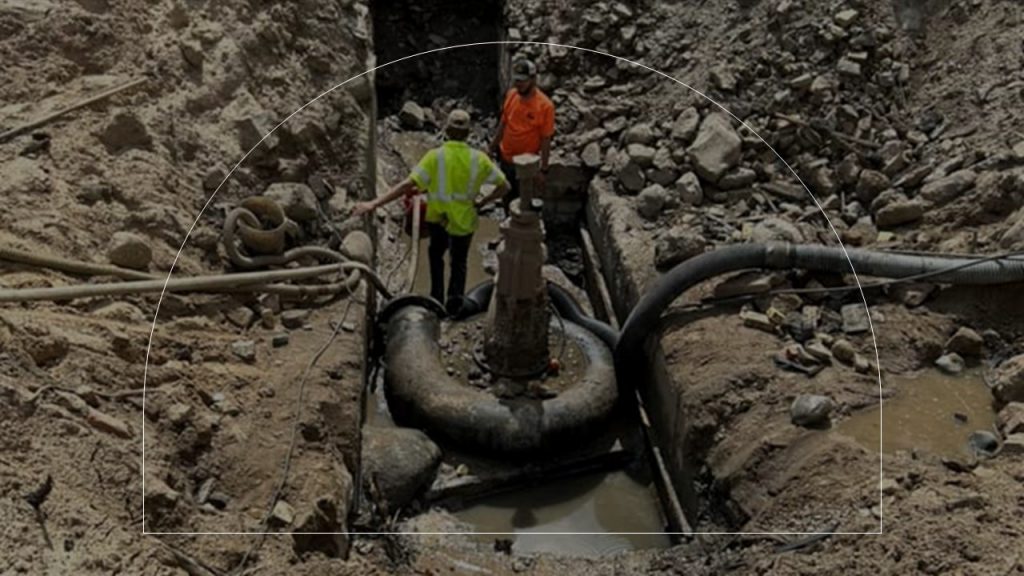
that will create access to the Grand River by the summer 2025.
Photo Credit: Connor Veenema
As Chuck had stepped around the fenced corner to get a photo, he had commented to a museum worker who’d been on a break. “That’s part of the first hydroelectric power plant in the world.” The museum clerk nodded with a response. “Yup. I heard it’s going to be part of an outdoor display.”
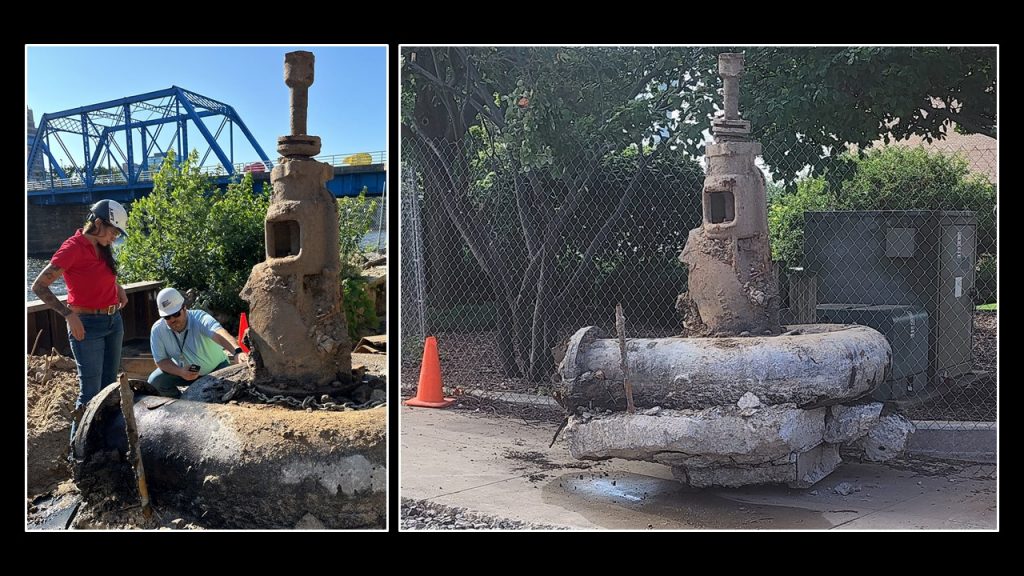
along the Grand River near the Public Museum.
Photo Credit: (left) Grand Rapids Public Museum (right) Chuck Hayden
“Wait a minute. . . THIS had generated electricity a hundred years ago?” I had furrowed my brow studying the photos when Chuck had arrived home. “From the river?” I clarified. Chuck had nodded. “Wow!” I had been befuddled by this artifact which had been underground over 80 years. Who’d placed it along the river bank? How had it created the first commercial electricity service in the world? I needed to know more!
Alex Forist
Alex Forist, Chief Curator at The Grand Rapids Public Museum, had been interviewed by Channel 3 News reporter, Teanna Barnes. “Because these are huge pieces of steel machinery, kind of what we’re envisioning, is more of an outdoor exhibit that uses them almost like sculptural pieces that can be interpreted and tell the story of the industrial history of this site about how the mill and the power plant and the different factories were using water power from the canal going back to the 1860’s and 1870’s.”
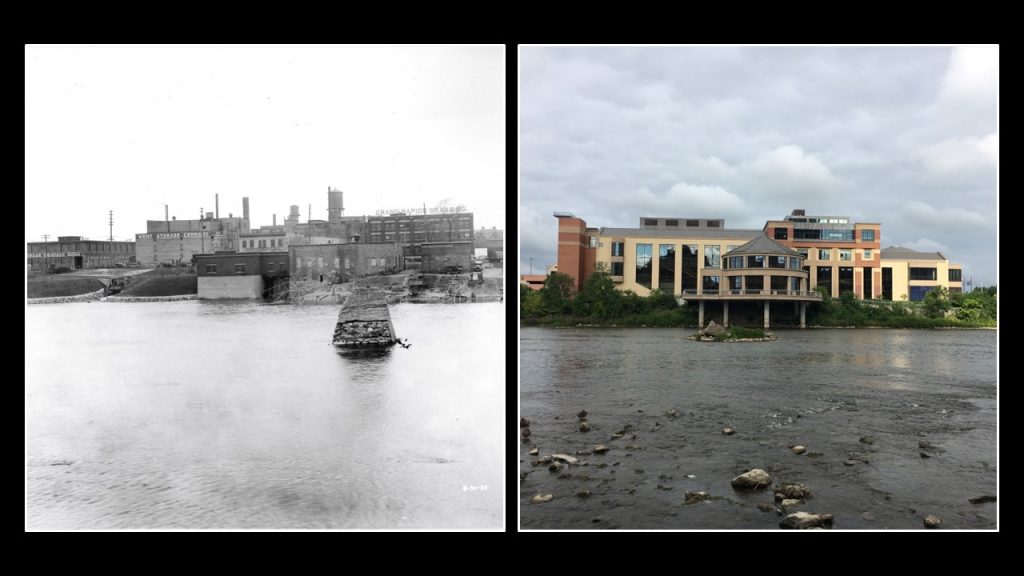
(left) Grand Rapids Electric Light and Power Company and The Grand Rapids Public Museum (right)
Photo Credit: Grand Rapids Hydroelectric Power Facebook Page
Jim Winslow
Local historian, Jim Winslow, had shared, “I’ve been researching through old newspaper clippings from the 1940s. I pieced together that the Worthington 14″ Centrifugal Pump, if operated in reverse, would act as a water turbine. I do not know when it was installed in the 1888 Grand Rapids Electric Light & Power building but it last operated in 1932 and after several years as a storage warehouse, the building above was demolished in the 1940s. So the centrifugal pump/water turbine has been buried for 80–90 years.”
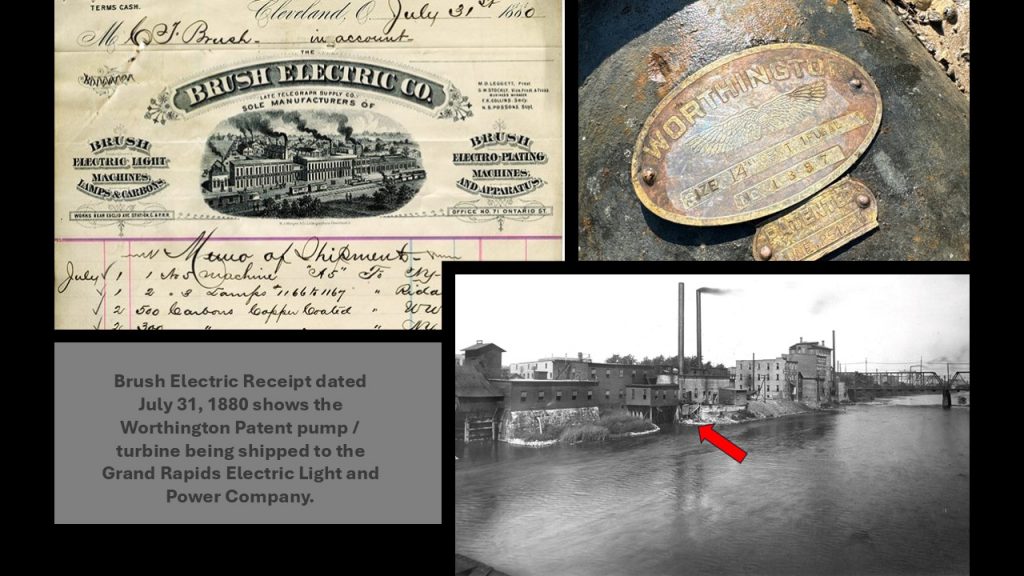
to Grand Rapids Electric Light & Power Company on July 13, 1880.
Photo Credits: Jim Winslow and Grand Rapids Hydroelectric Power
My mind swirled with wonderment about the city of Grand Rapids one hundred years ago. What had it been like back then? Who had been integral in creating “Furniture City?” I had to know!
William T. Powers
Born in New Hampshire on July 8, 1820, William T. Powers’ had studied and learned cabinet making skills within his first eighteen years. With $300.00 in his pocket, William T. Powers, his wife and son, William H. had made their journey to The Rapids on the Grand, which became known as Grand Rapids.
William had rented a bench in a small shop on the corner of Fountain and Ionia Streets. Using water power, he had made furniture for his showroom on Canal Street and exported many other pieces, too. With business booming, William T. Powers had been looking to expand.
In 1850 William T. Powers and Ebenezer M. Ball had formed a partnership, Powers & Ball. A couple of years later, they had opened a sawmill on Erie Street, employing forty people. By 1855 when the partnership had dissolved, William T. Powers had turned his focus to the lumber industry.
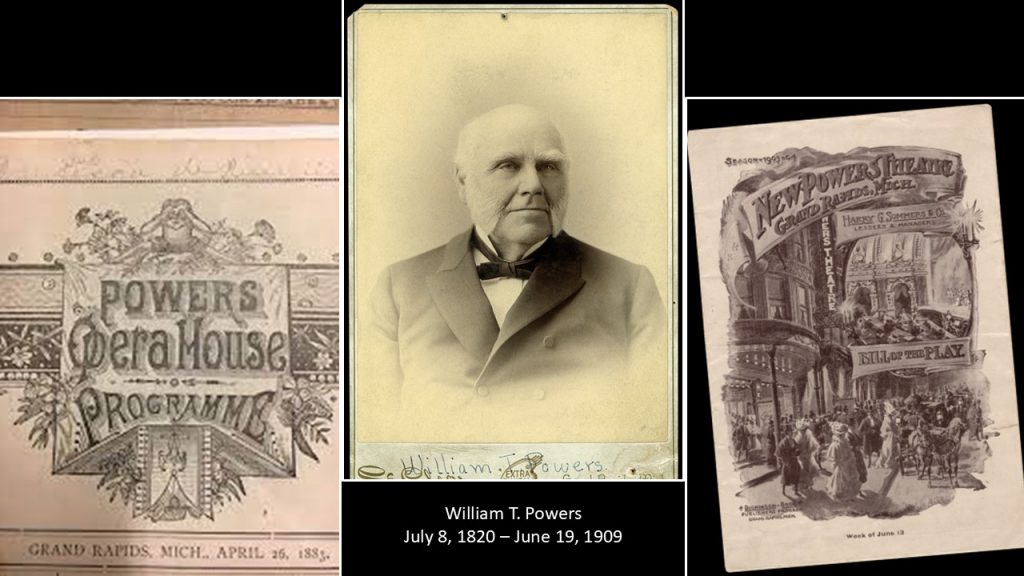
William T. Powers, a visionary for the community, had purchased river frontage and begun construction on the West Side Water Power Canal in 1865. By September 1868 more than thirty buildings had been constructed: mills, factories, homes and even the Powers’ Opera House. In addition there had been The Arcade Artesian Well where the community would gather and partake in free, refreshing water.
Interestingly in 1877, philanthropic and creative William T. Powers had heard of the “electric carbon-arc lighting system” from the Franklin Institute. William began experimenting and designing the first industrial hydropower in the world. His blue prints had been successfully constructed into the commercial electric carbon-arc hydropower along the canal. It had been the first of its kind!
The West Side Water Power Company’s service had started on July24, 1880. The Wolverine Chair and Furniture Factory, ran by son, William H. Powers, had sixteen brush-arc lamps lit by the water turbine. Other establishments which had been illuminated had been the Sweet’s Hotel, Powers’ Opera House, Mill & Lacey’s Drug Store, Preusser’s Jewelry Store, Spring & Company’s Dry Goods Store, Pierce’s Clothing Store and Star Clothing House.
The World’s First Hydroelectric Power Plant
With the community’s hearts warmed by the glow of electric lights, a contract had been drawn up for street lighting on March 29, 1881. Operations would need to be extended to meet the needs. So, a forty-light generator had been installed.
Soon, an even larger capacity of 256 Horse Power would be needed. So, a new permanent powerhouse had been designed by William T. Powers and assigned to builder, John H. Hoskin. Amazingly the world’s first commercial hydroelectric power plant had been completed by November 1881. William T. Powers had decided to re-name the “West Side Water Power Company” to “The Grand Rapids Electric Light & Power Company.”
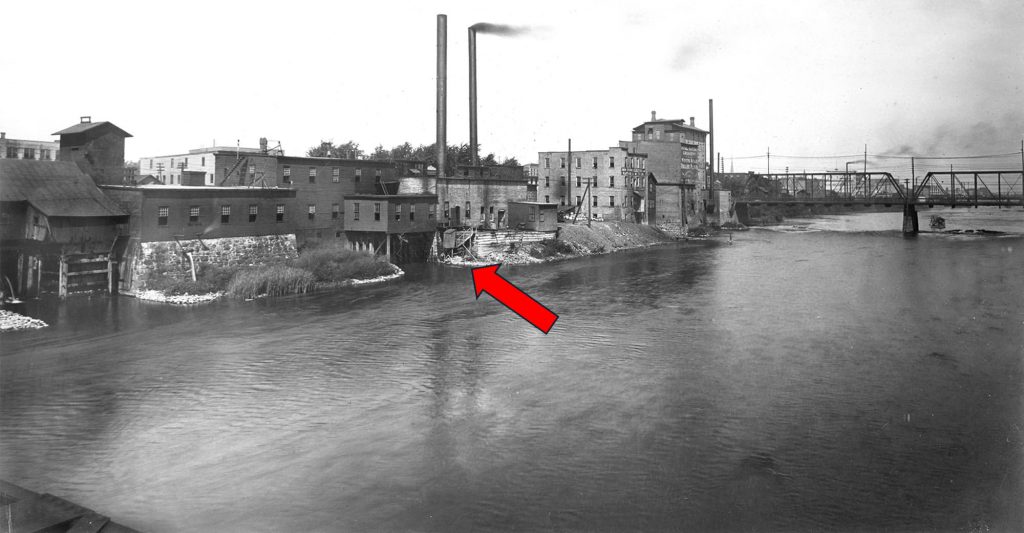
The arrow had been added by Chuck Hayden.
Tid Bits
According to William T. Powers’ grandson, Frederick W. Powers, his grandfather had experimented with incandescent lamps, but they would burn out within minutes due to a vacuum issue. This had been before Thomas Edison’s lamp in 1879.
William T. Powers had been Grand Rapids’ City Treasurer from 1853-1854. He had been elected Mayor in 1857, serving one term.
Years later the Electric Light and Power Company had become Consumers Electric Light and Power, which has been absorbed into part of Consumers Energy.
Ponderings
With the discovery of the 7,000 pound centrifugal pump and water turbine my curiosity had been peaked. This machine has given us a glimpse into the creative souls who’ve come before us and how they’ve engineered better lives for the community. Stay curious and make memories!
Resources:
“Powers Behind Grand Rapids” article
Grand Rapids Hydroelectric Power Facebook page
Grand Rapids Public Museum Facebook page
Teanna Barnes, News Channel 3 report
WOODTV 8 article
William T. Powers, Industrialist article
William Thompson Powers photo
News3 report





